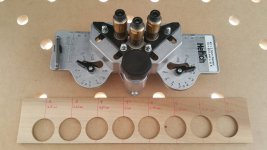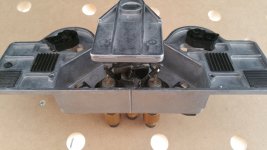I get better holes in every king of ply and melamine using a router rather than a drill. Even a 000 rpm drill. So my final solution must be a route based one.
And I have another particular need. I want all hole columns referenced off the front edge of the panel and I want all rows referenced off the bottom edge of the panel. That means no flipping anything around. That way any inconsistency of centering the bit, even slop in the system is pretty much canceled out. If anything is wrong it won't matter because holes will be the same amount wrong, shelves will be level. Even if the panel size is a little off, it won't matter.
I have an LR32 and I figured out a way to achieve my goal (even in the field) on my MFT using only Festool stock items plus spacer pieces. The holey rail is attached to the MFT bridge thing and I don't use the LR32 edge stops or the end stops. I use dogs and spacers. I think it's faster than the normal LR32 method. And it works on balanced or non-balanced panels.
All that said, if I was shopping right now. I'd give that Schmitt system a real hard look.


